【精编】雅思阅读判断题-精心整理
- 格式:ppt
- 大小:1.11 MB
- 文档页数:51
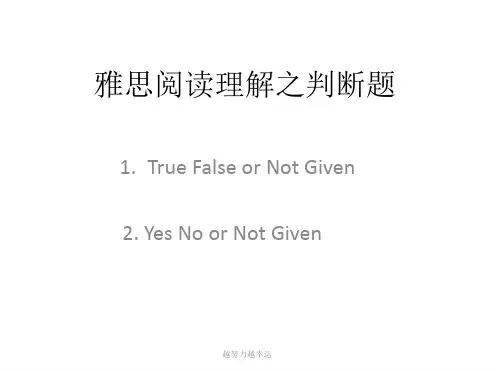
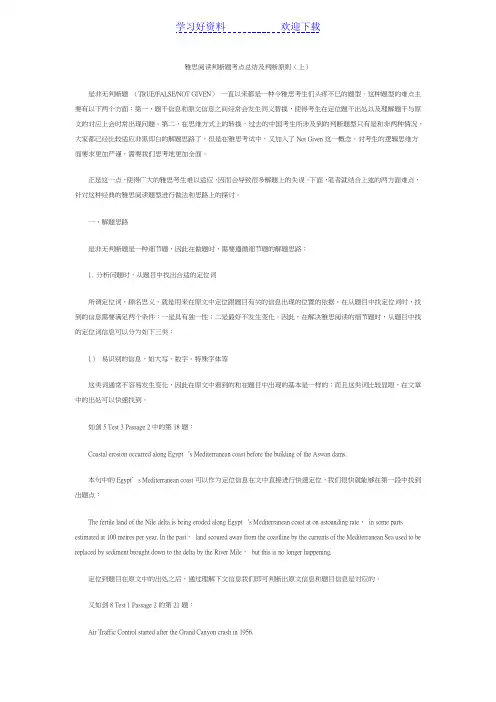
雅思阅读判断题考点总结及判断原则(上)是非无判断题(TRUE/FALSE/NOT GIVEN)一直以来都是一种令雅思考生们头疼不已的题型。
这种题型的难点主要有以下两个方面:第一,题干信息和原文信息之间经常会发生同义替换,使得考生在定位题干出处以及理解题干与原文的对应上会时常出现问题。
第二,在思维方式上的转换,过去的中国考生所涉及到的判断题型只有是和非两种情况,大家都已经比较适应非黑即白的解题思路了,但是在雅思考试中,又加入了Not Given这一概念,对考生的逻辑思维方面要求更加严谨,需要我们思考地更加全面。
正是这一点,使得广大的雅思考生难以适应,因而会导致很多解题上的失误。
下面,笔者就结合上述的两方面难点,针对这种经典的雅思阅读题型进行做法和思路上的探讨。
一、解题思路是非无判断题是一种细节题,因此在做题时,需要遵循细节题的解题思路:1. 分析问题时,从题目中找出合适的定位词所谓定位词,顾名思义,就是用来在原文中定位跟题目有关的信息出现的位置的依据。
在从题目中找定位词时,找到的信息需要满足两个条件:一是具有独一性;二是最好不发生变化。
因此,在解决雅思阅读的细节题时,从题目中找的定位词信息可以分为如下三类:1)易识别的信息,如大写、数字、特殊字体等这类词通常不容易发生变化,因此在原文中看到的和在题目中出现的基本是一样的;而且这类词比较显眼,在文章中的出处可以快速找到。
如剑5 Test 3 Passage 2中的第18题:Coastal erosion occurred along Egypt‘s Mediterranean coast before the building of t he Aswan dams.本句中的Egypt’s Mediterranean coast可以作为定位信息在文中直接进行快速定位,我们很快就能够在第一段中找到出题点:The fertile land of the Nile delta is being eroded along Egypt‘s Mediterranean coast at on astounding rate,in some parts estimated at 100 metres per year. In the past,land scoured away from the coastline by the currents of the Mediterranean Sea used to be replaced by sediment brought down to the delta by the River Mile,but this is no longer happening.定位到题目在原文中的出处之后,通过理解下文信息我们即可判断出原文信息和题目信息是对应的。
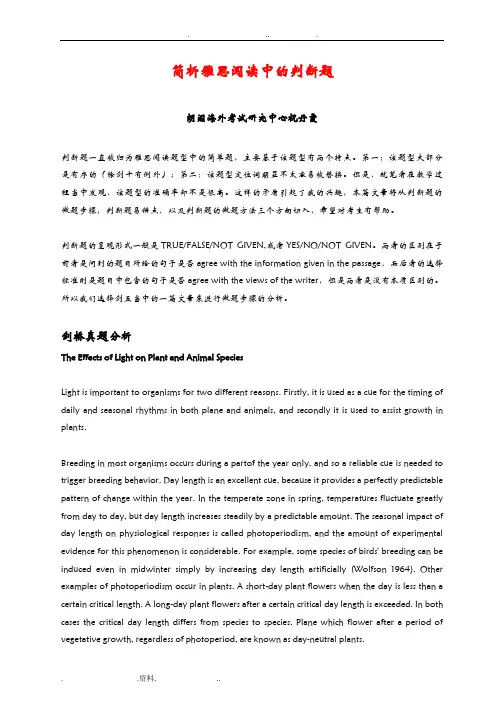
简析雅思阅读中的判断题朗阁海外考试研究中心祝丹霞判断题一直被归为雅思阅读题型中的简单题,主要基于该题型有两个特点。
第一:该题型大部分是有序的(除剑十有例外);第二:该题型定位词明显不太容易被替换。
但是,就笔者在教学过程当中发现,该题型的准确率却不是很高。
这样的矛盾引起了我的兴趣,本篇文章将从判断题的做题步骤,判断题易错点,以及判断题的做题方法三个方向切入,希望对考生有帮助。
判断题的呈现形式一般是TRUE/FALSE/NOT GIVEN,或者YES/NO/NOT GIVEN。
两者的区别在于前者是问到的题目所给的句子是否agree with the information given in the passage,而后者的选择标准则是题目中包含的句子是否agree with the views of the writer,但是两者是没有本质区别的。
所以我们选择剑五当中的一篇文章来进行做题步骤的分析。
剑桥真题分析The Effects of Light on Plant and Animal SpeciesLight is important to organisms for two different reasons. Firstly, it is used as a cue for the timing of daily and seasonal rhythms in both plane and animals, and secondly it is used to assist growth in plants.Breeding in most organisms occurs during a partof the year only, and so a reliable cue is needed to trigger breeding behavior. Day length is an excellent cue, because it provides a perfectly predictable pattern of change within the year. In the temperate zone in spring, temperatures fluctuate greatly from day to day, but day length increases steadily by a predictable amount. The seasonal impact of day length on physiological responses is called photoperiodism, and the amount of experimental evidence for this phenomenon is considerable. For example, some species of birds' breeding can be induced even in midwinter simply by increasing day length artificially (Wolfson 1964). Other examples of photoperiodism occur in plants. A short-day plant flowers when the day is less than a certain critical length. A long-day plant flowers after a certain critical day length is exceeded. In both cases the critical day length differs from species to species. Plane which flower after a period of vegetative growth, regardless of photoperiod, are known as day-neutral plants.Breeding seasons in animals such as birds have evolved to occupy the part of the year in which offspring have the greatest chances of survival. Before the breeding season begins, food reserves must be built up to support the energy cost of reproduction, and to provide for young birds both when they are in the nest and after fledging. Thus many temperate-zone birds use the increasing day lengths in spring as a cue to begin the nesting cycle, because this is a point when adequate food resources will be assured.The adaptive significance of photoperiodism in plane is also clear. Short-day plane that flower in spring in the temperate zone are adapted to maximizing seedling growth during the growing season. Long-day plants are adapted for situations that require fertilization by insects, or a long period of seed ripening. Short-day plane that flower in the autumn in the temperate zone are able to build up food reserves over the growing season and over winter as seeds. Day-neutral plane has an evolutionary advantage when the connection between the favorable period for reproduction and day length is much less certain. For example, desert annuals germinate, flower and seed whenever suitable rainfall occurs, regardless of the day length.The breeding season of some plants can be delayed to extraordinary lengths. Bamboos are perennial grasses that remain in a vegetative state for many years and then suddenly flower, fruit and die (Evans 1976). Every bamboo of the species Chusqueaabietifolio on the islandof Jamaica flowered, set seed and died during 1884. The next generation of bamboo flowered and died between 1916 and 1918, which suggests a vegetative cycle of about 31 years. The climatic trigger for this flowering cycle is not-yet known, but the adaptive significance is clear. The simultaneous production of masses of bamboo seeds (in some cases lying I2 to I5 centimeters deep on the ground) is more than all the seed-eating animals can cope with at the time, so that some seeds escape being eaten and grow up to form the next generation (Evans 1976).The second reason light is important to organisms is that it is essential for photosynthesis. This is the process by which plants use energy from the sun to convert carbon from soil or water into organic material for growth. The rate of photosynthesis in a plant can be measured by calculating the rate of its uptake of carbon. There is a wide range of photosynthetic responses of plants to variations in light intensity. Some plants reach maximal photosynthesis at one-quarter full sunlight, and others,like sugarcane, never reach a maximum, but continue to increase photosynthesis rate as light intensity rises.Plants in general can be divided into two groups: shade-tolerant species and shade-intolerant species. This classification is commonly used in forestry and horticulture. Shade-tolerant plane has lower photosynthetic rates and hence have lower growth rates than those of shade-intolerant species. Plant species become adapted to living in a certain kind of habitat, and in the process evolve a series of characteristics that prevent them from occupying other habitats. Grime (1966) suggests that light may be one of the major components directing these adaptations. For example, eastern hemlock seedlings are shade-tolerant. They can survive in the forest understory under very low light levels because they have a low photosynthetic rate.Questions 27-33Do the following statements agree with the information given in Reading Passage 3?In boxes 27 33 on your answer sheet, writeTRUE if the statement agrees with the informationFALSE if the statement contradicts the informationNOT GIVEN if there is no information on this27. There is plenty of scientific evidence to support photoperiodism.28. Some types of bird can be encouraged to breed out of season.29. Photoperiodism is restricted to certain geographic areas.30. Desert annuals are examples of long-day plants.31. Bamboos flower several times during their life cycle.32. Scientists have yet to determine the cue for Chusqueaabietifolia’s seasonal rhythm.33. Eastern hemlock is a fast-growing plant.上文笔者就提及了判断题的两个特点,其中之一就是绝大部分有序,所以这篇文章的定位相对来说就会比较简单。
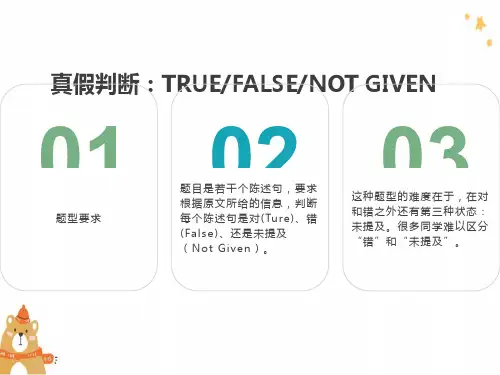
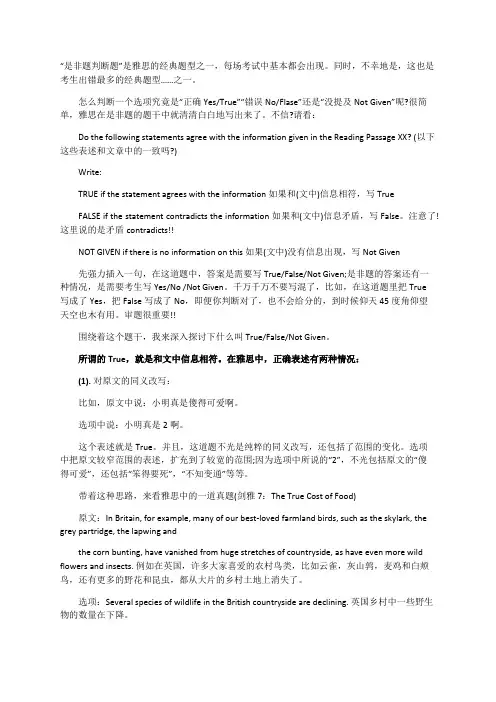
“是非题判断题”是雅思的经典题型之一,每场考试中基本都会出现。
同时,不幸地是,这也是考生出错最多的经典题型……之一。
怎么判断一个选项究竟是“正确Yes/True”“错误No/Flase”还是“没提及Not Given”呢?很简单,雅思在是非题的题干中就清清白白地写出来了。
不信?请看:Do the following statements agree with the information given in the Reading Passage XX? (以下这些表述和文章中的一致吗?)Write:TRUE if the statement agrees with the information 如果和(文中)信息相符,写TrueFALSE if the statement contradicts the information 如果和(文中)信息矛盾,写False。
注意了!这里说的是矛盾contradicts!!NOT GIVEN if there is no information on this 如果(文中)没有信息出现,写Not Given先强力插入一句,在这道题中,答案是需要写True/False/Not Given;是非题的答案还有一种情况,是需要考生写Yes/No /Not Given。
千万千万不要写混了,比如,在这道题里把True写成了Yes,把False写成了No,即便你判断对了,也不会给分的,到时候仰天45度角仰望天空也木有用。
审题很重要!!围绕着这个题干,我来深入探讨下什么叫True/False/Not Given。
所谓的True,就是和文中信息相符。
在雅思中,正确表述有两种情况:(1).对原文的同义改写:比如,原文中说:小明真是傻得可爱啊。
选项中说:小明真是2啊。
这个表述就是True。
并且,这道题不光是纯粹的同义改写,还包括了范围的变化。
选项中把原文较窄范围的表述,扩充到了较宽的范围;因为选项中所说的“2”,不光包括原文的“傻得可爱”,还包括“笨得要死”,“不知变通”等等。
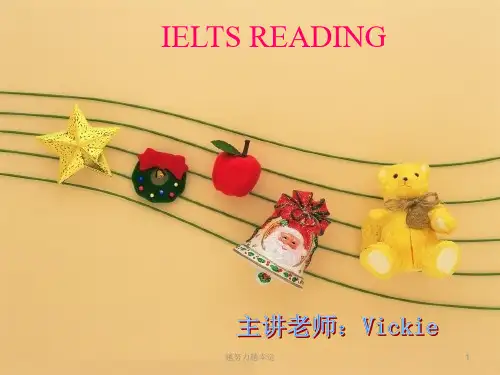
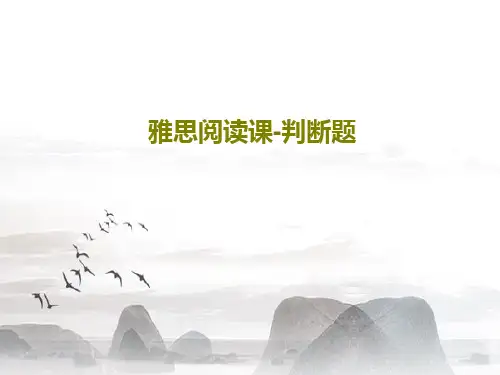

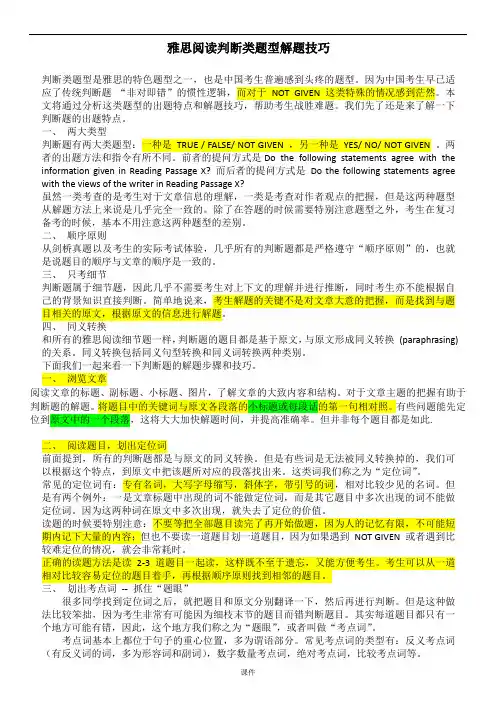
雅思阅读判断类题型解题技巧判断类题型是雅思的特色题型之一,也是中国考生普遍感到头疼的题型。
因为中国考生早已适应了传统判断题“非对即错”的惯性逻辑,而对于NOT GIVEN 这类特殊的情况感到茫然。
本文将通过分析这类题型的出题特点和解题技巧,帮助考生战胜难题。
我们先了还是来了解一下判断题的出题特点。
一、两大类型判断题有两大类题型:一种是TRUE / FALSE/ NOT GIVEN ,另一种是YES/ NO/ NOT GIVEN 。
两者的出题方法和指令有所不同。
前者的提问方式是Do the following statements agree with the information given in Reading Passage X? 而后者的提问方式是Do the following statements agree with the views of the writer in Reading Passage X?虽然一类考查的是考生对于文章信息的理解,一类是考查对作者观点的把握,但是这两种题型从解题方法上来说是几乎完全一致的。
除了在答题的时候需要特别注意题型之外,考生在复习备考的时候,基本不用注意这两种题型的差别。
二、顺序原则从剑桥真题以及考生的实际考试体验,几乎所有的判断题都是严格遵守“顺序原则”的,也就是说题目的顺序与文章的顺序是一致的。
三、只考细节判断题属于细节题,因此几乎不需要考生对上下文的理解并进行推断,同时考生亦不能根据自己的背景知识直接判断。
简单地说来,考生解题的关键不是对文章大意的把握,而是找到与题目相关的原文,根据原文的信息进行解题。
四、同义转换和所有的雅思阅读细节题一样,判断题的题目都是基于原文,与原文形成同义转换(paraphrasing) 的关系。
同义转换包括同义句型转换和同义词转换两种类别。
下面我们一起来看一下判断题的解题步骤和技巧。
一、浏览文章阅读文章的标题、副标题、小标题、图片,了解文章的大致内容和结构。
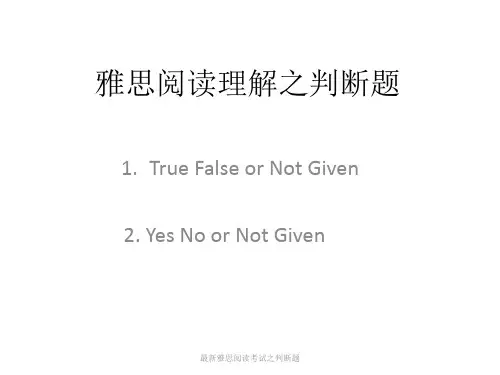

雅思阅读判断题正误解析雅思阅读中的判断题,看似简单的对错,其实也难分辨,所以,雅思频道小编为你整理了《雅思阅读判断题正误解析》,希望对考生有所帮助。
以C7T4P1为例:“Clemmons found a strange hieroglyph on the wall of an Egyptian monument.”【题目】分析:“Clemmons”在埃及纪念碑的墙上发现了一个奇怪的象形文字。
解题思路:通过显性词人名和特殊名词定位,即“Clemmons和hieroglyph, wall, monument.”“Now a Californian software consultant called Maureen Clemmons has suggested that kitesmight have been involved. While perusing a book on the monuments of Egypt, she noticed ahieroglyph that showed a row of men standing in odd postures.” 【原文】答案分析:文意理解:“Clemmons在浏览关于埃及纪念碑的书籍的时候发现了象形文字”。
题目是在墙上发现的象形文字,和原文正好矛盾。
以C7T2P3为例:“Phase I of MIRTP consisted of a survey of household expenditure on transport.”【题目】分析:MIRTP项目的第一阶段主要包括对家庭出行开支的调查。
解题思路:“Phase I, MIRTP”的定位以及考点词“household expenditure”的定位。
“Little was known about the transport demands of the rural households, so Phase I, betweenDecember 1985 and December 1987, focused on research.The socio-economic survey of morethan 400 households in the district indicated that a household in Makete spent, on average, seven hours a day on transporting themselves and their goods.”【原文】答案分析:文意理解:“Phase I 的调查主要关于当地400多户家庭平均每天花费7小时用于出行和货物运输。
雅思阅读是非判断题一、是非题介绍要求:题目是若干个陈述句,要求根据原文所给的信息,判断每个陈述句是对(True/Yes)、错(False/No)、还是未提及(Not Given)TRUE:题干和原文一致FALSE:题干和原文矛盾,不可能同时成立NOT GIVEN:题干不能确定,有可能对,有可能错。
题干可能和原文同时成立。
二、解题步骤步骤一:定位,找出题目在原文中的出处。
1、阅读题目,找出题目中的关键词。
2、最好先定位到原文中的一个段落,从头到尾快速阅读该段落,根据题目中的关键词,在原文中找出对应句。
3、仔细阅读相应对应句,根据第二大步中的原则和规律,确定正确答案。
注意:要注意顺序性,即题目的顺序和原文的顺序基本一致。
步骤二:判断,根据下列原则和规律,确定正确答案。
顺序原则舍得原则考点唯一原则不涉及逻辑理解而考查语言理解不能添加个人主观看法三、True/Yes的判断标准情况一:题目是原文的同义表达。
通常用同义词或同义结构。
例1原文:Few are more than five years .译文:很少有超过五年的。
题目:Most are less than five years .译文:大多数都小于五年。
例2原文:Frogs are losing the ecological battle for survival, and biologists are at a loss to explain their demise.译文:青蛙失去了生存下来的生态竞争能力,生物学家不能解释它们的死亡。
题目:Biologists are unable to explain why frogs are dying.译文:生物学家不能解释为什么青蛙死亡。
例3原文:Food production has kept pace with soaring populations mainly because of the expansion of artificial irrigation systems that make possible the growth of 40% of the world‟s food.译文:食品供应能跟上人口剧增主要是由于人工灌溉系统的增长使得世界粮食产量提高了40%。